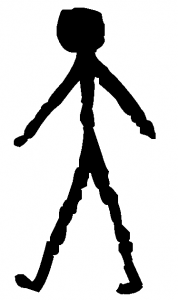
A walking stick figure, the letter “N” from Nancy Blackett’s Semaphore Font
One of my favorite leaders during my time at KeyCorp was a walker. He’d catch us early in the morning as he walked around the 6th floor. There were certainly faster or shorter ways to get to his office, but he’d take a little bit longer route in the morning just to see what was going on.
He wasn’t spying on us or checking up on us, just walking around. Most of the time he didn’t even stop and chat, just smiled, said “good morning” and walked the aisles to his office.
Occasionally he’d bring something up, but more frequently, we’d flag him down and give him an update on something, a problem or solution we’d been working on that we knew he’d be interested in.
This was a fairly-senior manager, three levels above me and four above the people I managed. Not surprisingly, he knew many of our names and could greet us as such in the hallway. Nothing major, but the personal touch was felt and I sensed a big loss when he left the organization the first time.1
A different pace
I had a direct manager that also walked. It seemed she would walk when she had too much energy and wanted to walk something off. It was almost always a frantic pace. I never did figure out if it was something she needed to do when talking or it encouraged a conversation or what the purpose was. But we walked fairly often and it was during those times that I got a deeper sense of what drove her, of what mattered to her and how she thought.
Of the two styles, the first seems closer to the “managing by walking around“, popularized by perhaps Tom Peters.
For finding issues and fixing systems
I employ it and encourage my people to use it as a tool in desktop and LAN management. Walk around the floor, catch people’s eyes, be accessible and smile! In this sense, it’s akin to a police officer’s beat, not that you’re trying to stop crime but building a closer relationship to increase your effectiveness. Let your users catch you, stop you and tell you about what’s going on with their desktop, their applications and their perception of your network. It’s a great way to spot patterns and develop holistic solutions rather than fixing the same problem multiple times.
How do you use walking as a leadership tool? Do you see it in use by the leaders around you?
- Yes, the first time. He came back a while later at an even higher position before leaving some years after that. ↩

